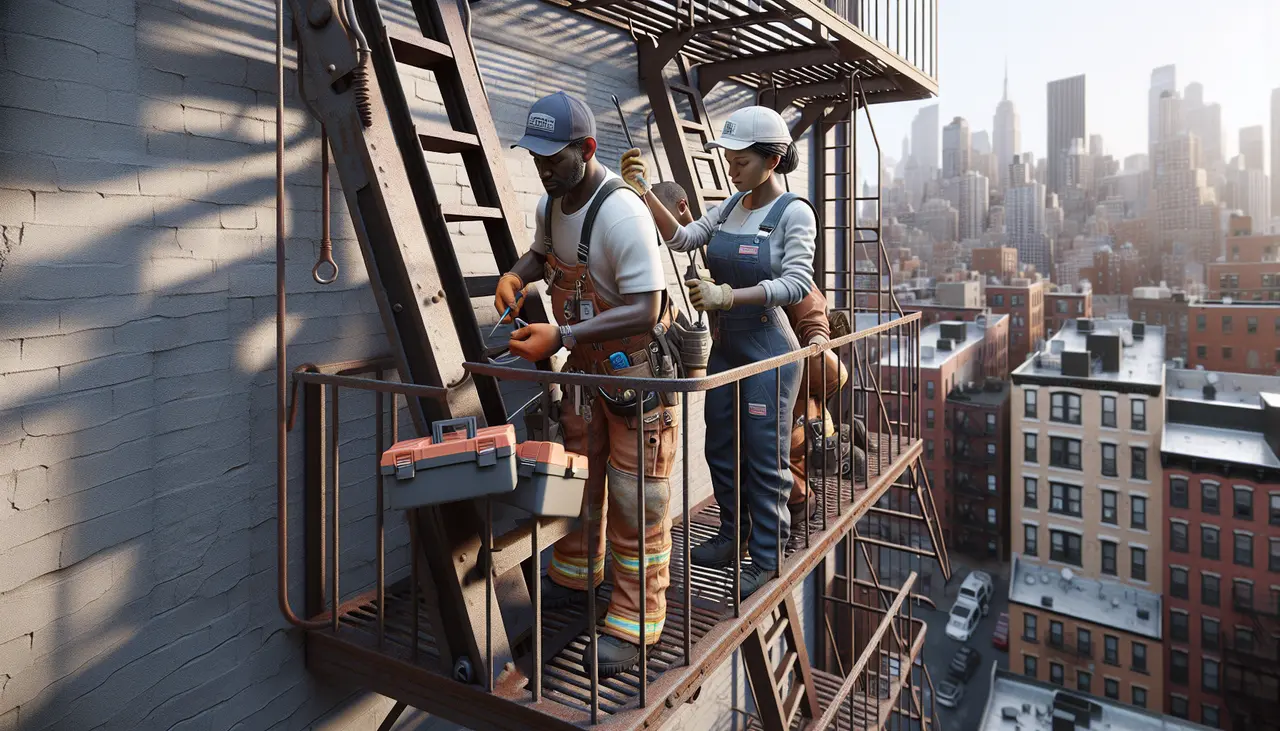Ensuring the safety of your building’s fire escape system is not just a regulatory requirement; it’s a moral obligation. Learn how fire escape contractors recommend you keep this lifeline in top condition.
1. Understanding Your Fire Escape’s Structure
The first step in fire escape maintenance is understanding its structure. A comprehensive knowledge of the components—from ladders to platforms, railings to exit doors—is essential. Each part is crucial in ensuring the system’s reliability during an emergency. Fire escape contractors emphasize the importance of familiarizing yourself with these elements, as they form the foundation of effective maintenance and inspection routines.
2. Regular Inspection Schedules
Staying on top of regular inspections is non-negotiable. Fire escape contractors recommend conducting thorough inspections at least once a year. However, areas exposed to harsh weather conditions may require more frequent checks. These inspections are vital to identifying issues like rust, corrosion, or structural weaknesses before they escalate into major hazards. An inspection checklist should include checking bolts, welds, and attachment points to the building’s structure.
3. Identifying Rust and Corrosion Early
Rust and corrosion are the archenemies of metal fire escapes. These issues can quickly compromise the structural integrity of your escape route. Identifying signs of rust and corrosion early is paramount. Look for discoloration, flaking metal, or any signs of deterioration, especially in joints and weld areas. Early detection allows immediate remediation, keeping repair costs low and safety high.
Contractors stress the importance of not overlooking minor rust spots, which can rapidly become severe problems. Regular cleaning and applying protective coatings can prevent rust and extend the lifespan of your fire escape.
4. The Importance of Immediate Repairs
Identifying any issues during inspections and prioritizing immediate repairs is essential. Even seemingly minor problems, like a loose step or a damaged handrail, can significantly impact the fire escape’s functionality in an emergency. Fire escape contractors often witness the consequences of delayed maintenance, which can lead to costly and extensive repairs down the line. Proactive maintenance ensures that your fire escape remains a safe egress path.
5. Proper Cleaning Techniques
Proper cleaning is more than just an aesthetic concern; it’s a safety measure. Accumulating debris, leaves, or snow can obstruct the fire escape routes, making them unusable in emergencies. Fire escape contractors recommend a regular cleaning schedule to ensure these pathways remain clear. Use brooms or leaf blowers for loose debris, and consider power washing for a more thorough clean. However, protect the metal surfaces from excessive moisture to prevent rust.
Cleaning is also the perfect opportunity to inspect the fire escape for any issues that need attention, making it a critical component of your maintenance routine.
6. Ensuring Clear Access Paths
Accessibility is key for effective fire escape use. Obstructions from internal clutter or external growth like vines and shrubbery can impede a swift evacuation. Ensure that the path to and from the fire escape, as well as the structure itself, remains clear at all times. This includes ensuring that doors and gates leading to the fire escape open easily and are never locked in a manner that could delay escape during an emergency.
7. The Role of Lubrication in Maintenance
Moving parts, such as hinges, bolts, and sliders, require regular lubrication to function smoothly. Fire escape contractors advise using appropriate lubricants based on the material of your fire escape to prevent rust and ensure these mechanisms operate seamlessly, especially under the stress of an emergency. This maintenance task is often overlooked but is vital for the operational reliability of fire escape systems.
8. Regular Weight Capacity Checks
Over time, the structural integrity of a fire escape can be compromised due to various factors, including wear and tear, weather conditions, and improper use. Conducting regular weight capacity checks, ideally by professional fire escape contractors, ensures that the structure can still support the designated load. Such assessments are crucial for older buildings where the fire escape might not have been subject to modern safety standards during installation.
9. Updating Safety Signage
Safety signage plays a pivotal role in guiding occupants during an evacuation. Ensure that signs indicating the fire escape’s location and instructions for its use are visible, legible, and illuminated where necessary. Updating these signs to reflect any changes in the building layout or evacuation procedures is essential for maintaining an effective and compliant fire escape strategy.
10. Educating Occupants on Fire Escape Use
An integral part of fire escape maintenance is ensuring that building occupants understand how to use it properly. Hold regular drills and instructional sessions to educate tenants, employees, or residents on correctly using the fire escape. This training should include opening access doors, descending the fire escape safely, and gathering at designated assembly points. Fire escape contractors often emphasize that a well-maintained fire escape system is only as effective as the people’s readiness to use it correctly.
11. Compliance with Local Fire Safety Regulations
Local laws and regulations regarding fire safety and escape systems can vary significantly. It’s essential to ensure that your fire escape maintenance practices comply with local fire safety authorities’ latest standards and requirements. Regular consultations with fire escape contractors can help navigate these regulations, ensuring your building meets all necessary safety codes and standards.
12. When to Consult Professional Fire Escape Contractors
While regular maintenance can be performed by building maintenance staff, there are times when consulting with professional fire escape contractors is necessary. Experts best handle complex repairs, structural modifications, or compliance audits. These professionals bring a wealth of experience and specialized knowledge, ensuring that your fire escape system meets legal requirements and provides a safe, reliable means of egress in an emergency.



